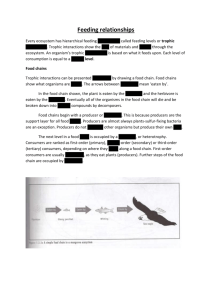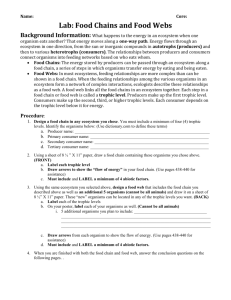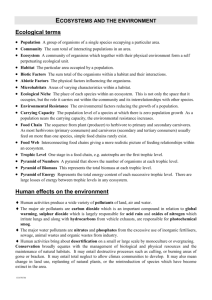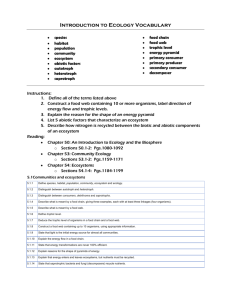Lesson Plan Draft
advertisement
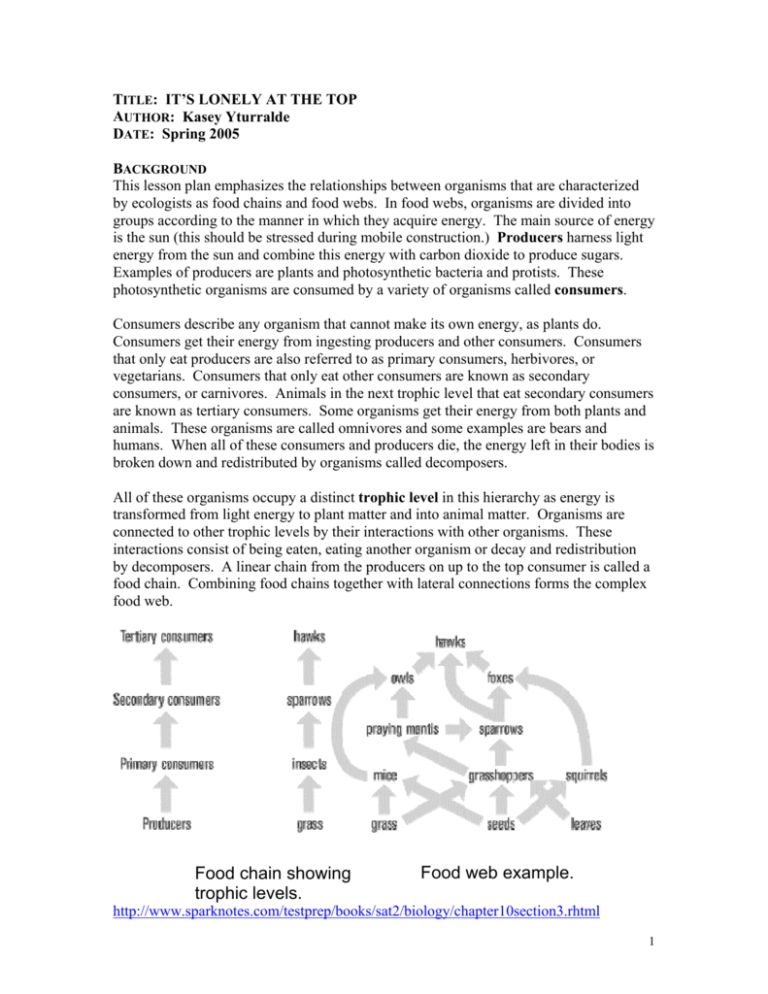
TITLE: IT’S LONELY AT THE TOP AUTHOR: Kasey Yturralde DATE: Spring 2005 BACKGROUND This lesson plan emphasizes the relationships between organisms that are characterized by ecologists as food chains and food webs. In food webs, organisms are divided into groups according to the manner in which they acquire energy. The main source of energy is the sun (this should be stressed during mobile construction.) Producers harness light energy from the sun and combine this energy with carbon dioxide to produce sugars. Examples of producers are plants and photosynthetic bacteria and protists. These photosynthetic organisms are consumed by a variety of organisms called consumers. Consumers describe any organism that cannot make its own energy, as plants do. Consumers get their energy from ingesting producers and other consumers. Consumers that only eat producers are also referred to as primary consumers, herbivores, or vegetarians. Consumers that only eat other consumers are known as secondary consumers, or carnivores. Animals in the next trophic level that eat secondary consumers are known as tertiary consumers. Some organisms get their energy from both plants and animals. These organisms are called omnivores and some examples are bears and humans. When all of these consumers and producers die, the energy left in their bodies is broken down and redistributed by organisms called decomposers. All of these organisms occupy a distinct trophic level in this hierarchy as energy is transformed from light energy to plant matter and into animal matter. Organisms are connected to other trophic levels by their interactions with other organisms. These interactions consist of being eaten, eating another organism or decay and redistribution by decomposers. A linear chain from the producers on up to the top consumer is called a food chain. Combining food chains together with lateral connections forms the complex food web. Food chain showing trophic levels. Food web example. http://www.sparknotes.com/testprep/books/sat2/biology/chapter10section3.rhtml 1 Trophic levels also describe the transfer of energy through a food web. As energy moves from one trophic level to the next, much energy is lost through respiration and heat loss. As a result, only about 10% of the energy in a given trophic level is transferred to the next. Along with this loss of energy, there is a reduction in the number of organisms and biomass at each higher trophic level. It is more “expensive”, energy-wise, to produce large consumers compared to the amount of energy needed to grow producers. It is important to consider food webs because they illustrate how organisms affect each other through direct and indirect interactions. Food webs can be disturbed by the introduction of new species, elimination of species, or pollutants. As pollutants move through food webs they may increase in concentration, a process called biomagnification. In biomagnification, pollutants may start out at relatively harmless levels. However, because biomass decreases at each trophic level, pollutants become increasingly concentrated toward the top of the food chain or food web. An example of this is the high concentration of mercury in fish that occupy high trophic levels. Mercury from the atmosphere settles onto the ocean surface and may enter the food chain through bacteria or plankton (free floating micro-organisms, some photosynthetic). These are consumed by fish (primary consumers), who themselves become food for other fish (secondary consumers or carnivorous fish). These fish may be consumed by tertiary consumers such as bears, alligators, birds or humans. OBJECTIVES Student will be able to 1. Construct a food web diagram 2. Model a food web using a mobile 3. Apply their knowledge of food webs to new ecosystems a. identify trophic levels b. describe how organisms fit into their food web GOALS Students will learn 1. How energy flows through natural systems 2. How we characterize organisms according to their energy source 3. How organisms affect one another through different trophic interactions 4. Learn how an addition, elimination or disturbance has far-reaching effects within food webs STANDARDS ARIZONA Grades 6-8 Strand 1: Inquiry process ¾ Concept 1: Observation, Questions and Hypothesis Formulate predictions, questions or hypotheses based on observations. Locate appropriate sources. ¾ Concept 2: Scientific testing (investigating and modeling) 2 Design and conduct controlled investigations. ¾ Concept 3: Analysis and Conclusions Analyze and interpret data to explain correlations and results; formulate new questions. ¾ Concept 4: Communication Communicate results of investigation. Strand 3: Science in Personal and Social Perspectives ¾ Concept 1: Changes in Environments Grade 6 Strand 4: Life Science ¾ Concept 1: Structure and Function in Living Systems ¾ Concept 3: Populations of Organisms in an Ecosystem Grade 7 Strand 4: Life Science ¾ Concept 3: Populations of Organisms in an Ecosystem NATIONAL Content Standard A: Science as inquiry Abilities necessary to do scientific inquiry Understanding about scientific inquiry Content Standard C: Life Science Populations and ecosystems MATERIALS Florida Everglades video (Any video that describes ecosystems and interactions between trophic levels.) Pencils Paper Branches/Twigs Twine Pre-cut pressed wood Wood paint Drill Old newspaper (to place over table while students are painting) TIMELINE Day 1 Pre-lab discussion Florida Everglades video Day 2 Student groups choose and research system (Students investigate systems using prepared information packets) Day 3 Groups being mobile construction: painting Day 4 Continue mobile construction: assembly Day 5 Mobile presentation and discussion Day 6 Assessment essay Extension 3 Day 1 ZOO trip GRADE LEVEL This lesson plan is designed for middle school grades 6-8. However, it could certainly be adapted for high school grades. PROCEDURE Day 1 Pre-lab discussion o What do you know about food webs? o What do you think you know about food webs? o What about food webs in unclear? o What do you want to know about food webs? o What does it mean to be “at the bottom of the food chain”? o Why are people warned not to eat too much fish? Florida Everglades Video Wrap –up discussion Day 2 Mobile Project o Students form groups and together choose a system: Sonoran Desert, California Chaparral, Redwood Forest, Antarctic, Coral Reef, o Students read about their system and fill out worksheet that helps them identify trophic levels and respective organisms Day 3 Mobile construction o Draw out schematic of food web o Draw organisms and prepare each piece for the mobile Day 4 Mobile construction o Place pieces on table and organize them before adding twine and connecting to mobile o Connect pieces at low trophic levels first o These pieces should form 2-4 food chains o Attach food chains to form food web Day 5 Mobile Discussion o Student groups present their food webs to the class o Class discussion o Where does energy ultimately come from? o Where would the sun go in your food web mobile? o Where does energy go? o Are all systems dependent on sun as primary energy source? o How do omnivores fit into food web model? Do they? o Discuss example of what happens when food webs are disturbed 4 Day 5 Summative Assessment o Students read short article about the elimination or addition of organism to a trophic level o Use real life example such as invasive species or extinctions o Students write news article for local community describing the issue and give suggestions for local citizens Extension ZOO trip Day 1 o Take students on trip to ZOO o Speak with ZOO staff to determine which exhibits would be best suited for discussion of food web o Present students with description of ecosystems at ZOO o Students complete scavenger hunt worksheets for producers and producers in African savannah, Sonoran desert and tropical rainforest GLOSSARY Trophic level: organisms in an ecosystem that obtain their energy from a common source Biomagnification: increasing concentration of a substance in successive trophic levels of a food chain Biomass: multiply the number of individuals in a population by the weight of an average individual in it, gives an estimate of the weight of the population; biomass decreases through successive trophic levels Consumers: group of organisms that get their energy by eating other consumers or producers Producers: organisms (green plants, photosynthetic bacteria and protists) that produce energy rich organic molecules upon which nearly all other organisms feed Food chain: describes path of energy as it moves from one organism to another Food web: complex series of interconnected food chains EVALUATION Formative assessment Students will participate in class discussions before lab activity to highlight their knowledge and concepts they have yet to grasp. Throughout the lesson students will join in discussions of ecological concepts. Summative assessment Students will read about an ecosystem in which a pesticide is being used and is suspected of having detrimental effects. Students will respond through a news article that 5 highlights characteristics of this food web and how they think pesticide is affecting plants and animals. Students will make recommendations to local citizens. EXTENSION Strange Days on Planet Earth video and curriculum o This is a very recent nature series by National Geographic that outlines how we have changed out environment on earth and the ultimate results. o The relevant volume in this series is the “Predator” video. o This video related to this lab because it describes how removing the species from the highest trophic levels has far-reaching effects. o There is accompanying curriculum that is very well done and all available to be downloaded from National Geographic’s website. o These lesson plans include background information and hands-on activities. WEBSITE RESOURCES http://www.nhptv.org/natureworks/nwstmich.htm Has multiple links that explain trophic levels. http://www.gould.edu.au/foodwebs/kids_web.htm Website with food web game. http://www.marietta.edu/~biol/102/ecosystem.html#FoodChainsandWebs4 Info about food webs and biomagnification. At good level for middle school. http://users.rcn.com/jkimball.ma.ultranet/BiologyPages/F/FoodChains.html#Food_Webs Info at higher level than middle school. http://www.ericdigests.org/2004-1/ecosystems.htm Discussion of eco-literacy and the standards. http://www.seattleaudubon.org/education.cfm?id=58 This website has one example of a food web lesson plan for 6th graders. http://www.sitesalive.com/oil/tg/private/oiltgfoodwebs.html This has a great idea of using a mobile to model a food chain. 6


